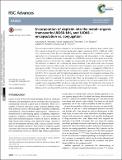Incorporation of cisplatin into the metal-organic frameworks UiO66-NH2 and UiO66 – encapsulation vs. conjugation.
Abstract
This work demonstrates synthetic strategies for the incorporation of an anticancer drug, cisplatin, and a Pt(IV) cisplatin prodrug into two zirconium-based metal-organic-frameworks (MOFs): UiO66 and UiO66-NH2. Cisplatin was chosen due to its reported high potency in killing ca. 95% of different cancers. Two approaches for its incorporation were investigated: conjugation and encapsulation. In the conjugation route, a Pt(IV) cisplatin prodrug was incorporated into UiO66-NH2 utilising its amine group in an amide-coupling reaction. In the second case, cisplatin was encapsulated into the large cavities of both MOFs. The presence of platinum was confirmed by energy-dispersive X-ray spectroscopy and microwave plasma-atomic emission spectroscopy. The cytotoxicity of the formulations was assessed on the A549 lung cancer cell line. The results show that the system in which cisplatin is conjugated to UiO66-NH2 is more efficient in inducing cell death than the materials where cisplatin is encapsulated into the pores of the MOFs. This is consistent with the higher drug loading achieved with the conjugation technique. One disadvantage of cisplatin therapy is that it may lead to thrombosis and, as a consequence, to heart attack and cardiac arrest. To ameliorate this potential side effect, we investigated the incorporation of NO (which has been widely researched for its antithrombotic properties) into the drug-loaded MOFs. All the cisplatin or pro-drug loaded MOFs are able to entrap and then release NO. Furthermore, the amount of NO released from these formulations is much greater than from the pure MOFs. As a result, the drug delivery systems developed in this work have potentially potent double functionality.
Citation
Mocniak , K A , Kubajewska , I , Spillane , D E M , Williams , G R & Morris , R E 2015 , ' Incorporation of cisplatin into the metal-organic frameworks UiO66-NH 2 and UiO66 – encapsulation vs. conjugation. ' , RSC Advances , vol. 5 , no. 102 , pp. 83648-83656 . https://doi.org/10.1039/C5RA14011K
Publication
RSC Advances
Status
Peer reviewed
ISSN
2046-2069Type
Journal article
Description
The authors wish to thank the EPSRC (EP/K005499/1 and EP/K025112/1) and the British Heart Foundation (NH/11/8/29253) for funding.Collections
Items in the St Andrews Research Repository are protected by copyright, with all rights reserved, unless otherwise indicated.

